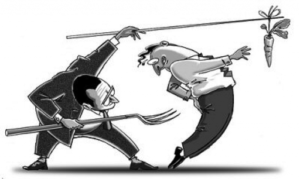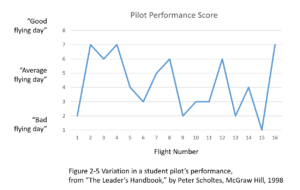SPIF Tips #24: Why Sales Incentives Can’t Improve Your Firm’s Sales Performance
 Does the following situation resemble your sales team?[1]
Does the following situation resemble your sales team?[1]
In the early 1970’s Israeli air force had a problem with instructors behaving abusively toward student pilots. A psychologist was hired to investigate. The instructors told him the performance of their students went up after criticism, and down after they were praised.
On learning the data confirmed these results, the psychologist gave up and went on to other things, chagrined and troubled.
Now, consider the behavior of salespeople in your company. When your company tries to reward good performance and penalize poor performance, what happens? Chances are you have the same conditions as our Israeli psychologist.
The story of the psychologist continues:
The psychologist went on to study the subject of variation. He realized that the students were part of a complex environment. There were many interacting conditions, factors, and events that were not stable. The weather varied, the planes varied, each with its own system of interacting parts that varied day to day. Further, the flight instructors varied, and the student pilots varied.
No one could know all the innumerable factors that affected the performance of a student pilot. With this new insight, the psychologist reexamined the performance of the student pilots. He had thought he was measuring their performance. In reality, he was measuring the outcome of a large number of unidentified factors.
It was not flight instructor’s reprimands or compliments that determined the pilot’s scores. Instead, other factors inherent in the system itself determined their performance. No one had direct control over the outcome.
Consider your sales team again. Are they affected too by uncontrollable factors? Here is a brief list of factors that might affect your sales team’s performance:
- The type of prospect or customer
- The past history and relationship with those individuals
- The salesperson’s industry background knowledge
- The salesperson’s sales skill and experience
- The context of each specific opportunity
- Your company’s product and services offering
- Pricing and packaging of the services
- Time available to prepare for sales meetings
- The competitive environment
- The sales tools or lack of them available to the salesperson
Isn’t it safe to say that like the student pilots, a variety of factors affects your sales team?
If so, consider Figure 2-5 below, which illustrates the scores achieved by student pilots over a series of flight tests. When data is presented in a manner like this, patterns become visible:
Here’s a pattern:
When is an instructor likely to compliment a student? Probably on flights 2, 4, 8, or 12, when their scores are relatively high. When is an instructor likely to reprimand a student? Probably on flights 1, 9, 13, and 15, when their scores are relatively low.
It is easy to see that performance is going to revert from peaks in either direction toward an average somewhere in the middle.
Ahh wait … “Some of our salespeople perform better than others. Surely that proves a difference among them.” It might. But the same is true of the student pilots. Someone is guaranteed to come out on top, in the middle, and on the bottom of any measurements. Unfortunately, such measures can’t tell you anything about those individuals. That requires an understanding of how the elements within the system interact.
- Edwards Deming taught that there are two types of variation: Common cause variation is built into the system. It is the result of multiple influences. The other type of variation is special cause variation. It is attributable to a knowable influence or unique event. These things are measurable if you try.
Systems – especially ones involving human beings – are often complex and counter intuitive. The example of the Israeli pilots shows this. Carrots and sticks don’t change how things work. They merely cause people to distort or game the system instead.
Actually fixing the system requires you and your sales team to understand what is driving it.
Action Item:
Consider the factors affecting your team’s outcomes. It’s a good idea to get your team to help you create the list. Then, separate out the things that can be measured and controlled, from the ones that can’t. Chances are you’ll get a new, more productive perspective on what to improve.
Michael
[1] Paraphrased from “The Leader’s Handbook,” by Peter Scholtes, McGraw-Hill 1998, page 26


